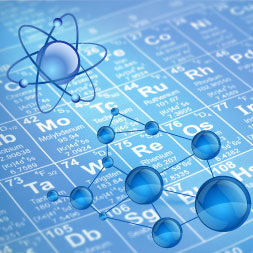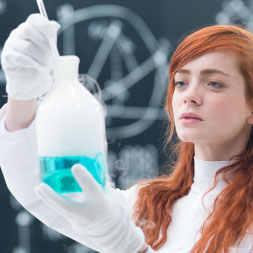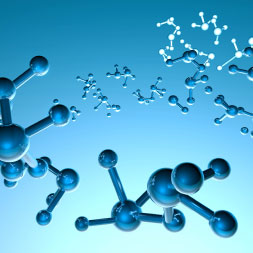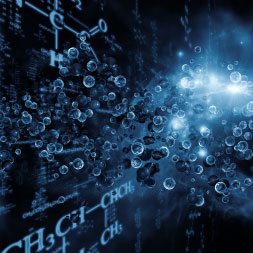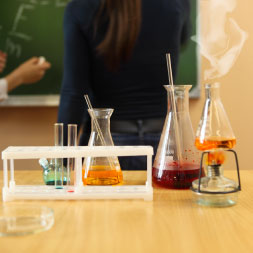Online courses directory (423)
Spectroscopy is the study of the interaction between matter and electromagnetic radiation. Molecules respond to different types of radiation in different ways, depending on the frequency (?) or wavelength (?) of the radiation. In General Chemistry, we studied spectroscopy as a tool for explaining the quantum mechanical model of the atom. In that course, we learned that light is an electromagnetic radiation of a wavelength that is visible to the human eye. We also learned that light, which exists in tiny “packets” called photons, exhibits properties of both waves and particles, a characteristic referred to as the wave-particle duality. The quantized relationship is defined as E = hv, where E is energy, h is Plank’s constant, and v is frequency. Spectroscopy and spectrometry are often used in chemistry for the identification of substances through the spectrum from which they are emitted or by which they are absorbed. The type of spectroscopic technique is defined by the type of radia…
This is an undergraduate introductory laboratory subject in ocean chemistry and measurement. There are three main elements to the course: oceanic chemical sampling and analysis, instrumentation development for the ocean environment, and the larger field of ocean science.
This course is offered through The MIT/WHOI Joint Program. The MIT/WHOI Joint Program is one of the premier marine science graduate programs in the world. It draws on the complementary strengths and approaches of two great institutions: the Massachusetts Institute of Technology (MIT) and the Woods Hole Oceanographic Institution (WHOI).
This course covers chemicals in our environment and in our bodies and how they impact our health. It addresses policies and practices related to chemicals, particularly related to how they get into our bodies (exposures), what they do when they get there (toxicology), how we measure them (biomonitoring) and their impact on our health.
This course is designed to cover subjects in advanced high school chemistry courses, correlating to the standard topics as established by the American Chemical Society. This course is a precursor to the Advanced Chemistry Coursera course. Areas that are covered include atomic structure, periodic trends, compounds, reactions and stoichiometry, bonding, and thermochemistry.
Two fundamental aspects of chemistry are, firstly, the structure of the atom and the role of the subatomic particles neutrons, protons and electrons, and, secondly, the atomic structure of the known elements that make up everything and how their place in the Periodic table of the elements determines their chemical properties. This free online course will give learners a comprehensive knowledge and understanding of these two core building blocks within chemistry. The course starts by examining the structure of the atom and subatomic particles, and then discusses the elements, and breaks them down into their subatomic structure of protons, neutrons and electrons. You will learn how the structure of each element determines its place in the Periodic table and its chemical properties. This course will be of great interest to all students who wish to pursue a career in any of the sciences such as chemistry, physics, biology or geology, or the individual learner who simply wants to learn and understand what the world around us is made up of.<br />
Gases behave differently from either solids or liquids, so there are different methods for understanding their behaviour. Having neither fixed volume nor shape gases are moulded entirely by the container in which they are held and from this it is possible to measure their behaviour by measuring properties such as pressure, volume, temperature and number of molecules. This free online chemistry course will introduce the concept of the ideal gas and the ideal gas law which is a good indicator of the behaviour of gases under many different conditions. The various components in the ideal gas law are explained in clear terms and you will see that by using equations you will understand how the impact of a change to one property, for example temperature, will impact on the other properties. Where there are multiple gases in a container you will be shown how to work out their partial pressure relative to the total pressure. This free online chemistry course will be of great interest to all students who wish to pursue a career in any of the sciences such as chemistry, physics, biology or geology, and to the individual learner who simply wants to learn and understand how gases behave.<br />
A molecule is a group of two or more atoms that bind together using chemical bonds. They may be from one or multiple elements and it is the ratio, or mass composition, of each molecule that gives the molecular compound its chemical characteristics. In this free online science course, you will learn about molecules and how they are composed of various elements, in mass, atoms and ratios. The course introduces the student to Avogadro’s number or the Mole, which is used to convert between atomic mass and grams, so that you will be able to work out ratios and weights of molecules. You will also learn how to balance chemical equations, and by balancing the reactants within equations, get viable chemical reactions. This branch of chemistry is known as Stoichiometry. The course will be of great interest to all students who wish to pursue a career in any of the sciences such as chemistry, physics, biology or geology, or the individual learner who simply wants to learn and understand how atoms form the molecules which make up all the material surrounding us. <br />
Matter exists in four states - solid, liquid, gas and plasma and it will change state depending on the temperature and pressure applied to the matter. In this free online chemistry course about states of matter you will learn about the characteristics of each of the four states and the amount of energy that can be added to or taken from a substance before it starts to change state. As all substances change state at different temperatures and pressures you will learn how to use phase change diagrams to plot the energy and pressure levels, the triple point, critical temperature, boiling and melting points associated with different substances. You will also learn in a step by step manner how to calculate the change in energy needed to move a substance along the state of matter spectrum. This free online chemistry course will be of great interest to all students who wish to pursue a career in any of the sciences such as chemistry, physics, biology or geology, or the individual learner who simply wants to learn and understand what is happening when matter changes from solid to liquid to gas.<br />
The amount of energy required to change the state of a substance depends on how strong or weak the bonds between the molecules are. For substances with strong bonds at standard temperature and pressure, like diamonds, it is extremely difficult to separate the molecules, whereas substances with weak bonds, like helium, remain in a gaseous form and do not condense into liquid or solid states. In this free online chemistry course you learn more about factors that affect the chemical nature of substances. You will learn why substances changing state can also be affected by mixing substances together. The course explains about using water as a solvent and mixing in different substances to see the effect on the boiling and melting points of the solution. This is followed by step by step examples of working out what the change in boiling or melting point will be based on the amount of solute added. This free online chemistry course will be of great interest to all students who wish to pursue a career in any of the sciences such as chemistry, physics, biology or geology, or the individual learner who simply wants to learn more about factors that affect the chemical nature of substances.<br />
Get a basic overview of microbiology before exploring advanced topics like bacterial cell morphology, nitrogen fixation and protozoan diseases through this online Education Portal course, Biology 103: Microbiology. Watch our video lessons on STDs, bacterial diseases and foodborne illnesses as you prepare to earn real college credit through the Microbiology Excelsior Exam . Though the subjects covered in these lessons are somewhat intense, our experienced, knowledgeable instructors have kept the videos brief, engaging and easy to follow. You also can benefit from the multiple-choice quizzes and written transcripts that complement each video.
The focus of this guided inquiry laboratory is to foster critical thinking that allows students to design, perform, and interpret experiments. In addition, the student acquires technical skills that are required for further advancement in experimental sciences. Although an ability to collect and analyze data in a quantitative manner is developed, the emphasis of the course is to provide a qualitative understanding of the basic concepts of chemistry. This is accomplished by demonstrating that chemical principles are derived from experimental data. The goal is to provide students both with a more accurate picture of the scientific process and with skills that are relevant to solving real life problems. Course Level: Undergraduate This Work, Chemistry 125/126 - General Chemistry Laboratory 1, by Nancy Kerner is licensed under a Creative Commons Attribution-ShareAlike license.
CHEM 216 builds on the experimental approach started in CHEM 211. Students participate in planning exactly what they are going to do in the laboratory by being given general goals and directions that have to be adapted to fit the specific project they will be working on. They use microscale equipment, which requires them to develop manual dexterity and care in working in the laboratory. They also evaluate the results of their experiments by checking for identity and purity using various chromatographic and spectroscopic methods. Course Level: Undergraduate This Work, Chemistry 216 - The Synthesis and Characterization of Carbonyl Compounds, by Ginger Shultz is licensed under a Creative Commons Attribution-ShareAlike license.
Organic Chemistry of Macromolecules covers the preparation, reactions, and properties of high molecular weight polymeric materials of both natural and synthetic origin. As a part of this course, U-M students collaboratively created and edited Wikipedia articles. Course Level: Graduate This Work, Chemistry 538 - Organic Chemistry of Macromolecules, by Anne McNeil is licensed under a Creative Commons Attribution-ShareAlike license.
Physical Organic Chemistry covers the principles of chemical bonding, mechanisms of organic chemical reactions and stereochemistry. The important types of organic reactions are also discussed, with an emphasis on basic principles. As a part of this course, U-M students collaboratively created and edited Wikipedia articles. Student contributions can be found within the Sessions tab. Course Level: Graduate This Work, Chemistry 540 - Physical Organic Chemistry, by Anne McNeil is licensed under a Creative Commons Attribution-ShareAlike license.
This course is an intensive introduction to the techniques of experimental chemistry and gives first year students an opportunity to learn and master the basic chemistry lab techniques for carrying out experiments. Students who successfully complete the course and obtain a "Competent Chemist" (CC) or "Expert Experimentalist" (EE) rating are likely to secure opportunities for research work in a chemistry lab at MIT.
Acknowledgements
The laboratory manual and materials for this course were prepared by Dr. Katherine J. Franz and Dr. Kevin M. Shea with the assistance of Professors Rick L. Danheiser and Timothy M. Swager. Materials have been revised by Dr. J. Haseltine, Dr. Kevin M. Shea, Dr. Sarah A. Tabacco, Dr. Kimberly L. Berkowski, Anne M. (Gorham) Rachupka, and Dr. John J. Dolhun.
WARNING NOTICE
The experiments described in these materials are potentially hazardous and require a high level of safety training, special facilities and equipment, and supervision by appropriate individuals. You bear the sole responsibility, liability, and risk for the implementation of such safety procedures and measures. MIT shall have no responsibility, liability, or risk for the content or implementation of any of the material presented.
Legal Notice
This course covers the process of brewing from grain to final bottle product and the chemical and biochemical process involved in each step. Students will be required to utilize previous knowledge in General and Organic chemistry to understand: analytical techniques in brewing, chemistry of the ingredients and products, and the molecules involved in the biochemical processes. During the course, students will also learn the similarities and differences between beer styles, home and commercial brewing processes, and analytical techniques. There is a great deal of Biochemistry and Organic Chemistry involved in the malting, mashing and fermentation process and understanding the chemistry behind the flavor, aroma, and color of beer. Students should have a basic knowledge of general and organic chemistry.
This course covers the process of brewing from grain to final bottle product and the chemical and biochemical process involved in each step. Students will be required to utilize previous knowledge in General and Organic chemistry to understand: analytical techniques in brewing, chemistry of the ingredients and products, and the molecules involved in the biochemical processes. During the course, students will also learn the similarities and differences between beer styles, home and commercial brewing processes, and analytical techniques. There is a great deal of Biochemistry and Organic Chemistry involved in the malting, mashing and fermentation process and understanding the chemistry behind the flavor, aroma, and color of beer. Students should have a basic knowledge of general and organic chemistry.
This course covers the process of brewing from grain to final bottle product and the chemical and biochemical process involved in each step. Students will be required to utilize previous knowledge in General and Organic chemistry to understand: analytical techniques in brewing, chemistry of the ingredients and products, and the molecules involved in the biochemical processes. During the course, students will also learn the similarities and differences between beer styles, home and commercial brewing processes, and analytical techniques. There is a great deal of Biochemistry and Organic Chemistry involved in the malting, mashing and fermentation process and understanding the chemistry behind the flavor, aroma, and color of beer. Students should have a basic knowledge of general and organic chemistry.
5.451 is a half-semester introduction to natural product biosynthetic pathways. The course covers the assembly of complex polyketide, peptide, terpene and alkaloid structures. Discussion topics include chemical and biochemical strategies used to elucidate natural product pathways.
This seminar will focus on three sports: swimming, cycling and running. There will be two components to the seminar: classroom sessions and a "laboratory" in the form of a structured training program. The classroom component will introduce the students to the chemistry of their own biological system. With swimming, running and cycling as sample sports, students are encouraged to apply their knowledge to complete a triathlon shortly after the term.
Trusted paper writing service WriteMyPaper.Today will write the papers of any difficulty.





